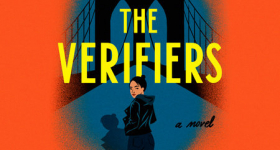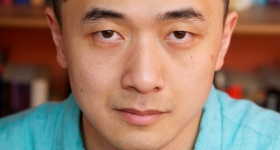Writer Neelanjana Banerjee | Illustrator Adrienne Yan
The other day, I boarded a crowded bus in a posh section of town. I had just completed an awkward celebrity interview for a women's magazine and I was hung over from staying out too late the night before. So when the hyper-looking white woman offered me her seat, I didn't think twice about why she was giving it to me over all the other people crushed into the front of the bus.
“I thought you'd like to sit down,” she said, nodding excitedly, as I swooped into the seat she vacated. “Considering you're pregnant and all.”
“Oh my god,” I thought, “she thinks I'm pregnant? Ew! I mean, this tunic is a little big and I'm a little bloated today, but… Oh god, should I tell her and give the seat back? That would be so embarrassing.” Instead, I held my ratty, nonprofit freebie tote bag in front of my belly, as if I were sheltering my happily developing fetus, and lied through my teeth in answer to Crazy Lady's questions about natural Indian birthing methods.
It occurred to me as I ran off the bus and was walking up the hill to my apartment that I had just had the perfect Asian American chick lit moment. I was the cranky, low-ranking journalist—substitute editorial assistant here if you wish—who was caught up in an embarrassing, yet potentially amusing, situation that I handled in a cowardly and awkward manner. All I needed to perfect the formula was to be carrying a Kate Spade bag, tripping over my Jimmy Choo heels and to have run into an auntie who wanted to set me up with her son, currently in medical school.
The genre now widely known as “chick lit” got its start in Britain, where there were a slew of working girl stories before Bridget Jones' Diary brought the lonely, self-deprecating, buffoon-like-yet-loveable female character to the forefront of a publishing revolution. But chick lit is also an equal opportunity genre. Throw identity issues, Asiaphiles and arranged marriages into the picture, and it seems like Asian Americans and chick lit are a match made by the highest paid matchmaker in Edison, NJ.
“[These books] go beyond the "girl-trapped-in-a-cubicle-looking-for-Mr. Right" story line, which I think "white girl chick lit" has become,” says Erika Tsang, an editor with Avon Trade, the chick lit imprint of HarperCollins. “It's a search for identity, to truly understand yourself in a society that doesn't always look like you, that doesn't have the same belief system you have.”
Yet after perusing a handful of the Asian American chick lit titles out there—Caroline Hwang's In Full Bloom (Plume), Kim Wong Keltner's The Dim Sum of All Things (Avon Trade), and Buddha Baby (Avon Trade) and Kavita Daswani's For Matrimonial Purposes (G.P. Putnam's Sons)—I felt the same kind of pride I did when Miko, Barbie's Pacific Islander friend, was introduced back in 1988: Is this something I should really be proud of?
Both Daswani and Hwang seem to have the chick lit writing credentials of writing for fashion magazines such as Women's Wear Daily and Mademoiselle, which allows them to conveniently place their protagonists at a fashion magazine and a PR firm, respectively. Keltner doesn't admit to such a background but also places her heroine, Lindsey Owyang, as the receptionist at a magazine. Amusingly, Lindsey works at Vegan Warrior magazine, and her antics as a closet meat eater at this send-up of San Francisco journalistic activism is one of the funnier parts of the novel. In fact, Keltner's books rise above the chick lit milieu through Lindsey's determined quirkiness. She certainly escapes the label-whorism that seems to affect both the Korean American Ginger Lee of Hwang's novel and husband-hunting Anju in Daswani's book.
Ethnic-specific chick lit has proved to be a hot commodity in recent years. Latina author Alisa Valdes-Rodriguez scored a hit with The Dirty Girls Social Club (St. Martin's), cashing in on the model that Terry McMillan found success with in the 1995 African American chick lit classic Waiting to Exhale (Pocket Books): a cast of different “ethnic” women dealing with life and love.
Tsang, who has worked in publishing for some 10 years, says that the market is crying out for more “ethnic” fiction. “Sales for chick lit aren't what it used to be,” she says. “There are just too many of these types of books on the market today, and readers are looking for a fresher story that gives them that something more than just dating, working and shopping.”
But in Asian American chick lit, dating remains central. Our Asian American protagonists are continuously forced to go out on dates with geeky Asian guys. Ginger gets set up on a date with a seemingly eligible Korean American bachelor who brings his white fiancé on the date. Lindsey spends most of Dim Sum pining for the pasty-sounding travel editor of her maga-zine, but goes out on a few dates with good Chinese boys, and some bad ones. Perhaps the best scene in Dim Sum is her date with “Gang Guy,” a San Francisco rice rocketeer who picks her up in his tricked out, purple Honda Civic and takes her to karaoke in Japantown.
And then there's Anju, 33, and still not married. Well, no wonder this woman's single—she's a complete bore! Perhaps this book would be interesting if Anju's own biggest goal in life wasn't getting married. When she is on her first date ever, at the age of 30, she “feels a soft stirring inside” when a Julio Iglesias song comes on. I'm sorry, you can wear as many pairs of Dolce & Gabbana mules under your saris as you want—you're just not cool.
Unlike Latina and African American chick lit, ethnic identity issues are another hallmark of Asian American chick lit. In In Full Bloom, when a Korean American date calls Ginger on her issues, she thinks, “I didn't really like Korean men and I steered clear of Koreans, but that didn't mean I wanted to be white.” Hmmm, or does it? And can't these characters be insecure and whiny without targeting their own ethnicity? At least Keltner's Lindsey seems to settle into herself in Buddha Baby, the sequel to Dim Sum, in which Lindsey considers cheating on her “white-devil boyfriend” with an Asian dude.
As Keltner's editor, Tsang sees the identity issues as the money shot. “Growing up Asian can be fun and uplifting, and the struggle to find one's identity can be an adventure that doesn't have to involve the water torture technique,” she says. “It's okay that some of us still embrace the Buddha, live with one's grandparents, and apply Tiger Balm to mosquito bites. [Keltner] brings all this out with humor and insight, and balances it with a sense of history. The combination is spot on and really resonates with readers.”
Sure, there are moments in these novels when I relate to the characters' struggles to find happiness. I even chuckled a bit at the embarrassing moments—though Lindsey's horrific “drinking too much and shitting herself at the party while wearing white pants on a first date with the guy she likes” experience was a little beyond my empathy—but overall, I found these books to be watered-down, slapsticky versions of Amy Tan, who might just be the real reigning queen of Asian American chick lit. For a more enriching experience than what's out there, skim The Joy Luck Club while watching Sex and the City. And throw on some designer heels while you're at it.
Neelanjana Banerjee is a contributing editor for Hyphen. She lives in San Francisco.









Comments